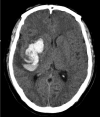Progress in translational research on intracerebral hemorrhage: is there an end in sight?
- PMID: 24139872
- PMCID: PMC3961535
- DOI: 10.1016/j.pneurobio.2013.09.007
Progress in translational research on intracerebral hemorrhage: is there an end in sight?
Abstract
Intracerebral hemorrhage (ICH) is a common and often fatal stroke subtype for which specific therapies and treatments remain elusive. To address this, many recent experimental and translational studies of ICH have been conducted, and these have led to several ongoing clinical trials. This review focuses on the progress of translational studies of ICH including those of the underlying causes and natural history of ICH, animal models of the condition, and effects of ICH on the immune and cardiac systems, among others. Current and potential clinical trials also are discussed for both ICH alone and with intraventricular extension.
Keywords: Animal models; Brain edema; Intracerebral hemorrhage; Iron.
Copyright © 2013 Elsevier Ltd. All rights reserved.
Figures







References
-
- Adams RE, Diringer MN. Response to external ventricular drainage in spontaneous intracerebral hemorrhage with hydrocephalus. Neurology. 1998;50:519–23. - PubMed
-
- Adeoye O, Broderick JP. Advances in the management of intracerebral hemorrhage. Nat Rev Neurol. 2010;6:593–601. - PubMed
-
- Al-Holou WN, O'Lynnger TM, Pandey AS, Gemmete JJ, Thompson BG, Muraszko KM, Garton HJ, Maher CO. Natural history and imaging prevalence of cavernous malformations in children and young adults. Journal of neurosurgery Pediatrics. 2012;9:198–205. - PubMed
-
- Aminova LR, Chavez JC, Lee J, Ryu H, Kung A, Lamanna JC, Ratan RR. Prosurvival and prodeath effects of hypoxia-inducible factor-1alpha stabilization in a murine hippocampal cell line. J Biol Chem. 2005;280:3996–4003. - PubMed
-
- Anderson CS, Huang Y, Arima H, Heeley E, Skulina C, Parsons MW, Peng B, Li Q, Su S, Tao QL, Li YC, Jiang JD, Tai LW, Zhang JL, Xu E, Cheng Y, Morgenstern LB, Chalmers J, Wang JG. Effects of early intensive blood pressure-lowering treatment on the growth of hematoma and perihematomal edema in acute intracerebral hemorrhage: the Intensive Blood Pressure Reduction in Acute Cerebral Haemorrhage Trial (INTERACT). Stroke. 2010;41:307–12. - PubMed
Publication types
MeSH terms
Grants and funding
LinkOut - more resources
Full Text Sources
Other Literature Sources

